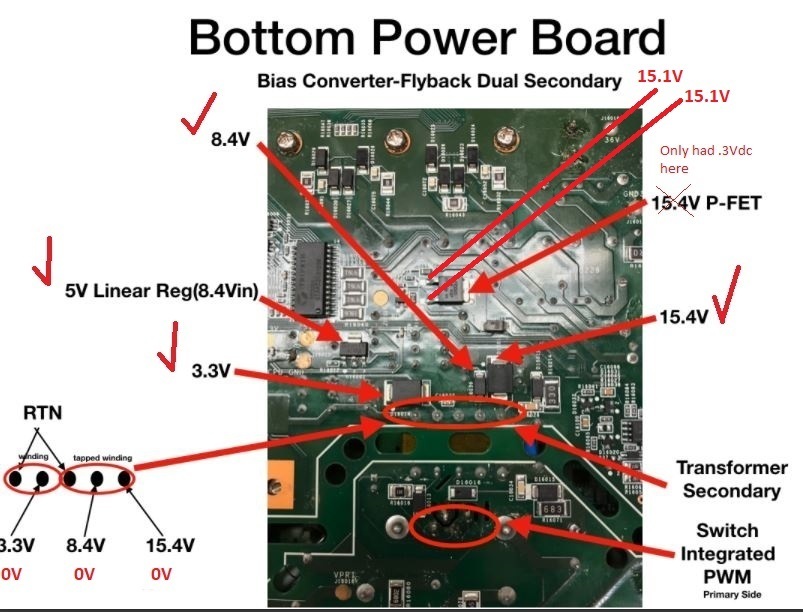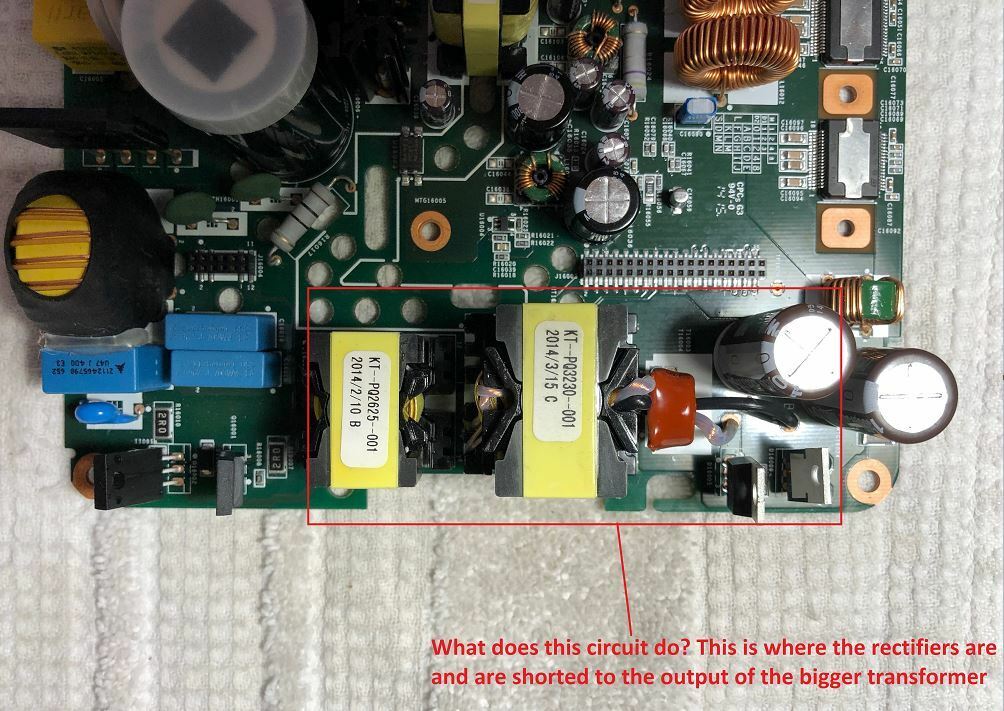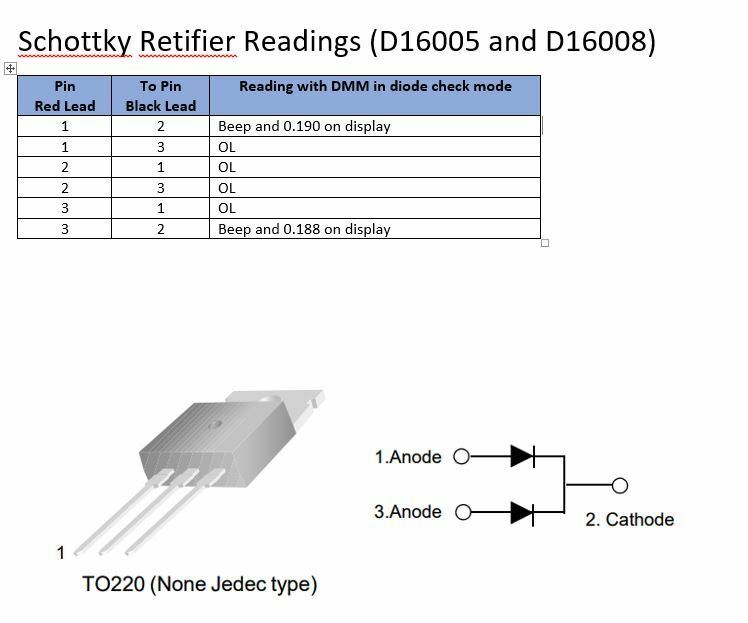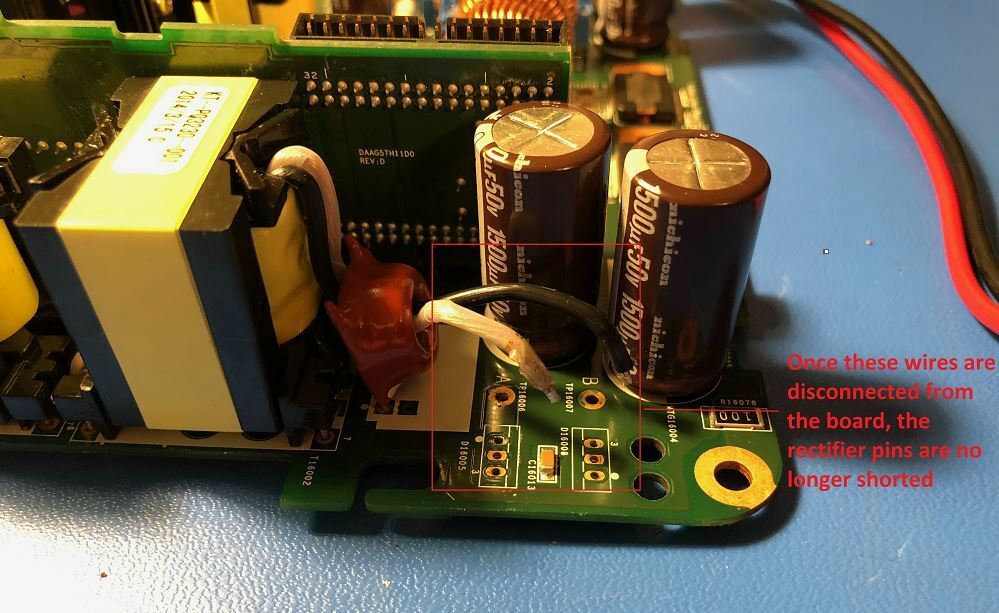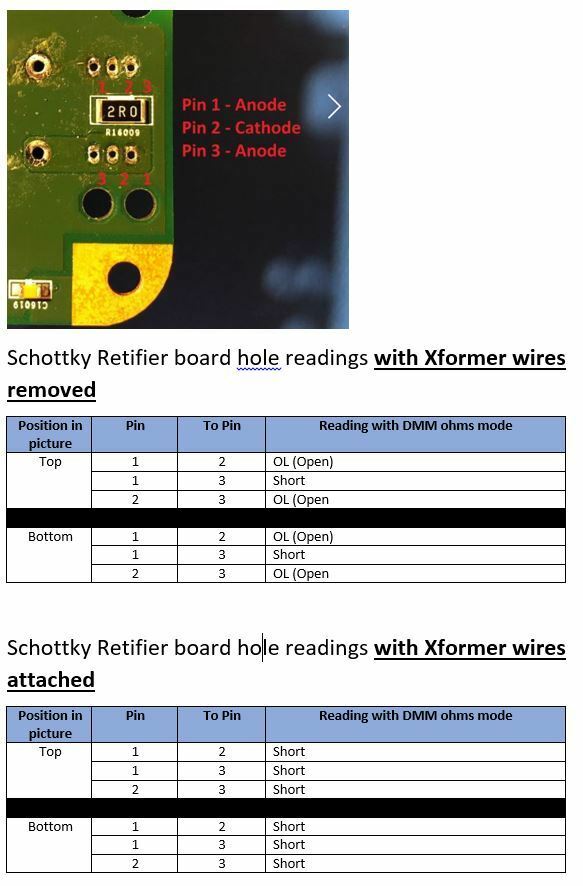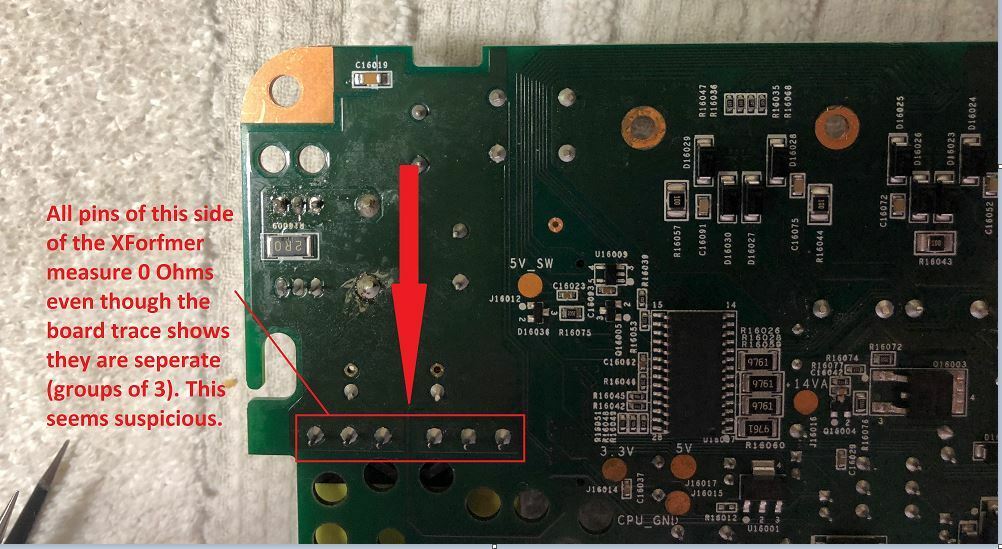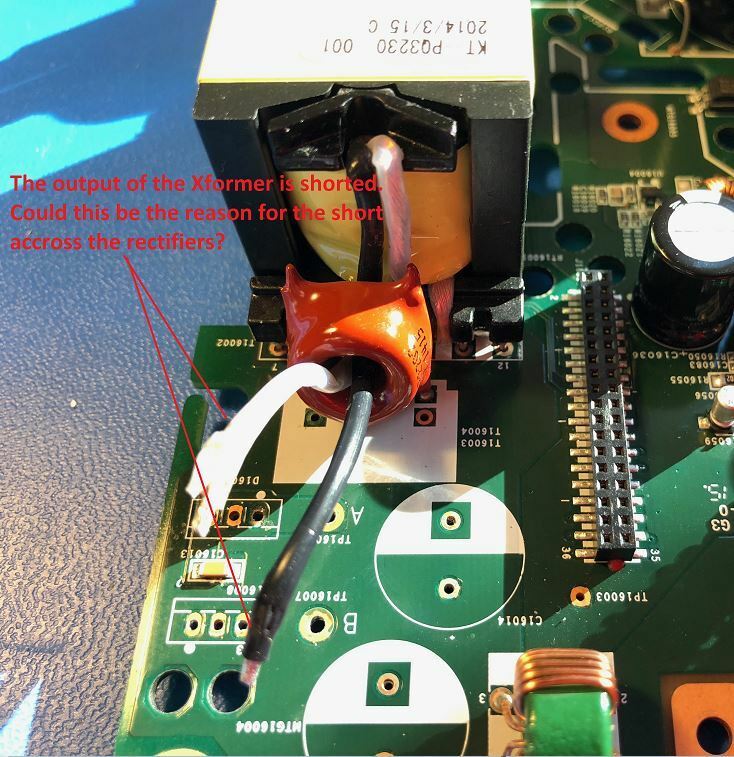The amp has no power. Is there an internal fuse for this unit?
Has anyone taken one apart?
Repair ZP120
- August 3, 2010
- 407 replies
- 46620 views
This topic has been closed for further comments. You can use the search bar to find a similar topic, or create a new one by clicking Create Topic at the top of the page.
407 replies
- Lyricist III
- January 7, 2018
Wait... I think your PWM is fine and I’m thinking that the secondary winding voltages just may not be measured properly. Looking at your secondary voltages downstream, everything looks nearly perfect. You shouldn’t be seeing the voltages if that secondary wasn’t working... so my guess is that your power supply is working fine. Getting back to the location where you had water damage... did you test the components near all that damage? Check diodes near that location as they are usually the first to go...
I’m just trying to think this through to help narrow the location...
I’m just trying to think this through to help narrow the location...
- Lyricist III
- January 7, 2018
@gruv2ths:
RE: I can only think of one thing left to do, and that is measure the output of the buck converter on the bottom of the logic card. There is a inductor with a (normally) yellow electrolytic cap. Solder a wire to the striped side of the cap and put the card back in and plug in. You can put the red lead on the wire and the black one to chassis. Should have 1.5V output.
I was able to get a wire on that cap (a bit of a test of my soldering skills) 😳 Anyway, I do have 1.5 VDC on that buck converter.
Also RE: if you are getting the 3.3,8ish,15 on the secondary then the bias converter PWM is working correctly.
I am actually NOT getting those voltages on the secondary. I measured for AC and DC and both are 0V. Also I keep wondering about that P-FET voltage you said you have 15.4 volts on. I do NOT have any voltage o at that test point. Could it be that the PWM is not getting a signal to turn on the switching transformer voltage? Or is the fact that I have voltage on the buck converter and the other caps I mentioned on the logic board an indication that the PWM and the switching power supply are functioning normally?
RE: I can only think of one thing left to do, and that is measure the output of the buck converter on the bottom of the logic card. There is a inductor with a (normally) yellow electrolytic cap. Solder a wire to the striped side of the cap and put the card back in and plug in. You can put the red lead on the wire and the black one to chassis. Should have 1.5V output.
I was able to get a wire on that cap (a bit of a test of my soldering skills) 😳 Anyway, I do have 1.5 VDC on that buck converter.
Also RE: if you are getting the 3.3,8ish,15 on the secondary then the bias converter PWM is working correctly.
I am actually NOT getting those voltages on the secondary. I measured for AC and DC and both are 0V. Also I keep wondering about that P-FET voltage you said you have 15.4 volts on. I do NOT have any voltage o at that test point. Could it be that the PWM is not getting a signal to turn on the switching transformer voltage? Or is the fact that I have voltage on the buck converter and the other caps I mentioned on the logic board an indication that the PWM and the switching power supply are functioning normally?
- Lyricist III
- January 7, 2018
Yeah... then something isn't right with that PWM. So for gruv2ths and me, we see 13.03V on pins 1 and 3 on the PWM. You are showing 15v. That's an interesting delta, but certainly not a deal breaker outside the spec. Its possible that voltage is higher because the switching isn't working quite right (when I had no switching at all, I read 44v). Just for giggles, is the PWM hot?
Did you test the P-FET? (see https://www.youtube.com/watch?v=gloikp9t2dA)
Did you test the P-FET? (see https://www.youtube.com/watch?v=gloikp9t2dA)
- Lyricist III
- January 7, 2018
I am actually NOT getting those voltages on the secondary. I measured for AC and DC and both are 0V. Also I keep wondering about that P-FET voltage you said you have 15.4 volts on. I do NOT have any voltage o at that test point. Could it be that the PWM is not getting a signal to turn on the switching transformer voltage? Or is the fact that I have voltage on the buck converter and the other caps I mentioned on the logic board an indication that the PWM and the switching power supply are functioning normally?
When you are checking the secondary, are you setting your ground on the RTN and the positive lead on the others? (I'm just dotting I's and crossing t's here)
- Lyricist III
- January 8, 2018
@m0untainman -
RE: Wait... I think your PWM is fine and I’m thinking that the secondary winding voltages just may not be measured properly. Looking at your secondary voltages downstream, everything looks nearly perfect. You shouldn’t be seeing the voltages if that secondary wasn’t working... so my guess is that your power supply is working fine. Getting back to the location where you had water damage... did you test the components near all that damage? Check diodes near that location as they are usually the first to go...
I am getting all of the proper voltages on the secondary side EXCEPT the pins on the transformer and the P-FET voltage. See the pic below for explanation.
Also RE: When you are checking the secondary, are you setting your ground on the RTN and the positive lead on the others? (I'm just dotting I's and crossing t's here)
Yes I am using the RTN points. I have also tried putting the black lead on the copper colored test point labeled "CPU_GND" as they are the same electrically as the RTN points (Verified by checking continuity)
Like you, I keep going back and forth between a power supply problem or something on the logic board. As far as checking the components I replaced on the logic boar, yes I have checked them and other components around them. All seem to be fine. This one is a real head scratcher. I am hoping either you or gruv2ths can provide some more insight.
Thanks so much for all the help you have provided so far!
RE: Wait... I think your PWM is fine and I’m thinking that the secondary winding voltages just may not be measured properly. Looking at your secondary voltages downstream, everything looks nearly perfect. You shouldn’t be seeing the voltages if that secondary wasn’t working... so my guess is that your power supply is working fine. Getting back to the location where you had water damage... did you test the components near all that damage? Check diodes near that location as they are usually the first to go...
I am getting all of the proper voltages on the secondary side EXCEPT the pins on the transformer and the P-FET voltage. See the pic below for explanation.
Also RE: When you are checking the secondary, are you setting your ground on the RTN and the positive lead on the others? (I'm just dotting I's and crossing t's here)
Yes I am using the RTN points. I have also tried putting the black lead on the copper colored test point labeled "CPU_GND" as they are the same electrically as the RTN points (Verified by checking continuity)
Like you, I keep going back and forth between a power supply problem or something on the logic board. As far as checking the components I replaced on the logic boar, yes I have checked them and other components around them. All seem to be fine. This one is a real head scratcher. I am hoping either you or gruv2ths can provide some more insight.
Thanks so much for all the help you have provided so far!
- Lyricist III
- January 8, 2018
Ok. That is helpful. My comment at this stage is carefully check your solder connections and traces around the PWM. You may want to put in another PWM if you have one if the traces are fine. That secondary really needs to have voltages if the PWM is working. That PWM is sensitive and rather easy to blow. Be thankful that you have more 🙂
- Lyricist III
- January 9, 2018
In order to do some more troubleshooting I wanted to check some of the voltage regulators that are mounted on the frame of teh amp, so I took the main board completely out and started looking around. All seemed normal until I got to 2 of the Schottky Barrier rectifiers near the 2 other transformers on the board (see pic for reference). I was taking some continuity readings and found that all 3 pins on both rectifiers seemed shorted. The traces on the board are hard to read but it looks like they are supposed to be that way? Anyway, to be thorough, I removed one of the rectifiers to test it and it tests good according to the data sheet. Positive lead on anode and negative lead on cathode gives beep on diode test. The other way around is open. I am puzzled by what this accomplishes since it seems both rectifiers are shorted to each other and one of the 2 wires coming from the bigger transformer. M0untainman or gruv2ths: Any ideas what this circuit does?
- Trending Lyricist I
- January 9, 2018
Yes, that is the 36V supply that comes on when you push play. It is kind of in parallels with the 15V supply.
Good catch. Definitely remove them. Once out see if the short is still there or was it the part. Lots of stuff is in parallel with that part of the circuit (caps and the output amp ICs).
Good catch. Definitely remove them. Once out see if the short is still there or was it the part. Lots of stuff is in parallel with that part of the circuit (caps and the output amp ICs).
- Lyricist III
- January 9, 2018
Yes... and you certainly don't want a short on a rectifier. That's one component that you should theoretically be able to test on board. After you remove it and test them (jut to be sure), look around for what else can be causing the short. Do you have an LCR meter to test the caps too?
- Lyricist III
- January 9, 2018
Good catch. Definitely remove them. Once out see if the short is still there or was it the part. Lots of stuff is in parallel with that part of the circuit (caps and the output amp ICs).
So then is the bigger transformer the 36V and the smaller the 15V supply? Do you have an amp that you can check to see what readings you get? I am in process of removing the other rectifier but this solder is not melting too easy and it is taking a while.
- Trending Lyricist I
- January 9, 2018
The 15V is provided by the bias converter. All the stuff in the red square above is the 36V supply.
- Lyricist III
- January 9, 2018
Thanks,
Any way you can give me some continuity readings from a good amp?
- Trending Lyricist I
- January 9, 2018
I cannot tonight, but I can tomorrow night.
Where would you like the readings from?
What are you measuring at the rectifier vias with the rectifiers removed?
Where would you like the readings from?
What are you measuring at the rectifier vias with the rectifiers removed?
- Lyricist III
- January 9, 2018
Thanks gruv2ths. If you would measure the following on the rectifiers:
Also if you could check the 6 pins of the transformer that is closest to the rectifiers. When I checked them last night, they were all shorted together.
- pin 1 to pin 2
- Pin 1 to 3
Also if you could check the 6 pins of the transformer that is closest to the rectifiers. When I checked them last night, they were all shorted together.
- Trending Lyricist I
- January 9, 2018
The transformer is just a bunch of coils of wire wrapped around a ferrite core, so yes with your DMM it will just look like it is all shorted together. That is normal.
As for the rectifier, i believe the outside pins are shorted together on the board and both outside pins should be high resistance to the center pin. Open the datasheet for that diode then google 'how to test a diode'. The package in question is just 2 diodes in one package. This is stuff that is good to know.
A short on the output of the 35V supply may explain why you have 0V on the Pfet. Maybe take your meter in ohms mode and measure (with the power off) the resistance from the pin of the Pfet that measures 0V to ground. I bet you will measure the same short you are measuring at the rectifiers.
As for the rectifier, i believe the outside pins are shorted together on the board and both outside pins should be high resistance to the center pin. Open the datasheet for that diode then google 'how to test a diode'. The package in question is just 2 diodes in one package. This is stuff that is good to know.
A short on the output of the 35V supply may explain why you have 0V on the Pfet. Maybe take your meter in ohms mode and measure (with the power off) the resistance from the pin of the Pfet that measures 0V to ground. I bet you will measure the same short you are measuring at the rectifiers.
- Lyricist III
- January 9, 2018
As for the rectifier, i believe the outside pins are shorted together on the board and both outside pins should be high resistance to the center pin. Open the datasheet for that diode then google 'how to test a diode'. The package in question is just 2 diodes in one package. This is stuff that is good to know.
A short on the output of the 35V supply may explain why you have 0V on the Pfet. Maybe take your meter in ohms mode and measure (with the power off) the resistance from the pin of the Pfet that measures 0V to ground. I bet you will measure the same short you are measuring at the rectifiers.
Yea I know the transformer should show a short on some pins put it was showing across all even though the solder traces looked like they were on separate circuits. As for the rectifiers I do have the data sheet and did test one that I removed and it tested good. I am planning on removing the other one tonight and test it as well.
Please let me know what you get for your readings. I am especially interested in the rectifier pins.
- Lyricist III
- January 10, 2018
I removed both rectifiers tonight and checked them while referencing the data sheet. Both seem to check out OK but I am hoping gruv2ths or m0untainman can double check my work and verify. Below are the readings I got from the rectifiers while removed from the board. My meter was in the diode check mode:
After checking the rectifiers I checked continuity on the board mounting holes where they were mounted and they were all points were still shorted. I then tried removing the 2 wires that were soldered near the rectifiers. These wires are coming from the bigger of the 2 transformers. After removing them the middle mounting hole is no longer shorted to the other 2 on both rectifier mounting locations. Sorry if I am not explaining this well so I am also including some pictures and tables with my findings below.
The end result seems to be that when the 2 wires from the Xformer are connected to the board all of the recifer pins are shorted together. When they are removed, only Pins 1 and 2 are shorted.
gruv2ths / m0untainman - Please let me know your thoughts on this.
Thanks,
Andy
After checking the rectifiers I checked continuity on the board mounting holes where they were mounted and they were all points were still shorted. I then tried removing the 2 wires that were soldered near the rectifiers. These wires are coming from the bigger of the 2 transformers. After removing them the middle mounting hole is no longer shorted to the other 2 on both rectifier mounting locations. Sorry if I am not explaining this well so I am also including some pictures and tables with my findings below.
The end result seems to be that when the 2 wires from the Xformer are connected to the board all of the recifer pins are shorted together. When they are removed, only Pins 1 and 2 are shorted.
gruv2ths / m0untainman - Please let me know your thoughts on this.
Thanks,
Andy
- Trending Lyricist I
- January 10, 2018
Lots of great stuff here.
Looks like the shiort is not the rectifier.
Like I mentioned earlier, there could be a lot of thing to cause a short at that point. Anything on the 36V bus.
Start taking off the electrolytic caps by one. Start with the 2 Big brown radial ones right next to the rectifiers.
Hope it’s not the Amps.
Looks like the shiort is not the rectifier.
Like I mentioned earlier, there could be a lot of thing to cause a short at that point. Anything on the 36V bus.
Start taking off the electrolytic caps by one. Start with the 2 Big brown radial ones right next to the rectifiers.
Hope it’s not the Amps.
- Lyricist III
- January 11, 2018
My soldering iron dies yesterday so I have to wait for a replacement to arrive before I can remove those caps. I also ordered a multimeter that has an ESR function to test the caps so I will know for sure if one of them is bad. Should have everything by the weekend and can update then.
- Lyricist III
- January 11, 2018
It's kind of a cheap one but it got pretty good reviews: https://www.amazon.com/gp/product/B00EYYJRC0/ref=oh_aui_detailpage_o01_s00?ie=UTF8&psc=1
Also go this soldering iron as the $20 one I had stopped melting solder after using it 3 times: https://www.amazon.com/gp/product/B01DGZFSNE/ref=oh_aui_detailpage_o00_s00?ie=UTF8&psc=1
Also go this soldering iron as the $20 one I had stopped melting solder after using it 3 times: https://www.amazon.com/gp/product/B01DGZFSNE/ref=oh_aui_detailpage_o00_s00?ie=UTF8&psc=1
- Lyricist III
- January 12, 2018
Hi gruv2ths - I still haven't received my meter and iron yet, but was looking around at the are where the caps are. I don't really see much that can be shorted and was wondering if you might have any theories. I am still going to remove the caps and test them, but wanted to think of the next steps if they check good.
- Lyricist III
- January 13, 2018
I took the caps out today and they checked out OK using a capacitance meter. With the caps out, I connected the 2 wires from the Xformer back to the board and all 3 pins of both rectifiers are shorted again. If I remove the wires, the pins measure what they are supposed to. Could it be that the 36V transformer is shorted out? There doesn't seem to be any damage to it.
- Lyricist III
- January 13, 2018
Good info ando1. The 2 wires will appear to short because its a winding. They should short as that's how a transformer works. See this to understand why:
https://en.wikipedia.org/wiki/Transformer#/media/File:Transformer3d_col3.svg
You should see a little bit of resistance on it (a few ohms?), but very small. If it has no continuity (i.e. full open), then it would be bad. Have a read on this to help on testing it:
http://www.ebay.com/gds/How-to-Test-a-24-Volt-Transformer-/10000000205661057/g.html
The rectifier will work by the switching (AC) back and forth of the polarities and current direction. Your rectifier numbers that you posted above look pretty reasonable. Check the data sheet to be sure the voltages that are going through as shown are within spec. But a cursory glance, it looks good to me.
What I would do is check the voltage on the primary winding when its powered up. Do you have any? This should be AC (or the transformer just wouldn't work). Again, if your secondary winding is showing 0v, then there is a switching problem somewhere as that transformer won't work without AC current of some form. You need to trace backwards until you start seeing voltage. That will likely indicate the general location of where the problem might be.
https://en.wikipedia.org/wiki/Transformer#/media/File:Transformer3d_col3.svg
You should see a little bit of resistance on it (a few ohms?), but very small. If it has no continuity (i.e. full open), then it would be bad. Have a read on this to help on testing it:
http://www.ebay.com/gds/How-to-Test-a-24-Volt-Transformer-/10000000205661057/g.html
The rectifier will work by the switching (AC) back and forth of the polarities and current direction. Your rectifier numbers that you posted above look pretty reasonable. Check the data sheet to be sure the voltages that are going through as shown are within spec. But a cursory glance, it looks good to me.
What I would do is check the voltage on the primary winding when its powered up. Do you have any? This should be AC (or the transformer just wouldn't work). Again, if your secondary winding is showing 0v, then there is a switching problem somewhere as that transformer won't work without AC current of some form. You need to trace backwards until you start seeing voltage. That will likely indicate the general location of where the problem might be.
- Lyricist III
- January 13, 2018
This should also explain why you will see a short on your rectifiers while in circuit:
https://sub.allaboutcircuits.com/images/quiz/02311x01.png
So its normal.
https://sub.allaboutcircuits.com/images/quiz/02311x01.png
So its normal.
Enter your E-mail address. We'll send you an e-mail with instructions to reset your password.
Scanning file for viruses.
Sorry, we're still checking this file's contents to make sure it's safe to download. Please try again in a few minutes.
OKThis file cannot be downloaded
Sorry, our virus scanner detected that this file isn't safe to download.
OK

